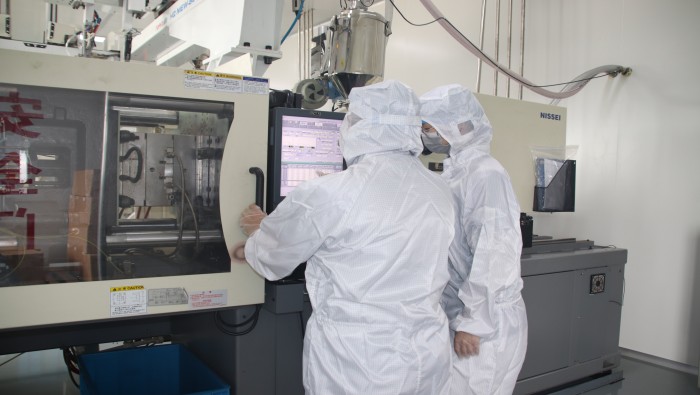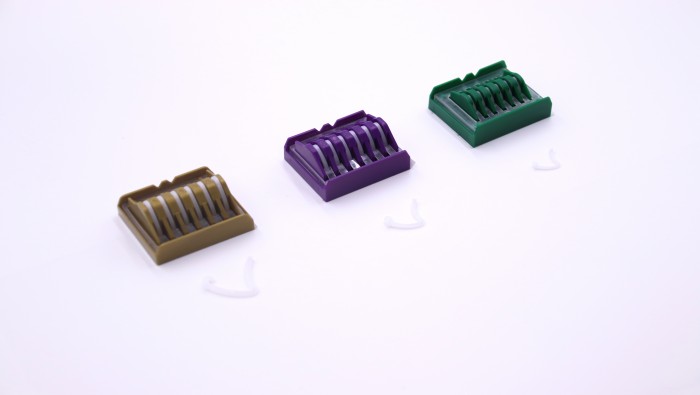

Disposable tissue closure clips are important tools for hemostasis and tissue fixation in surgery, usually using POM (paraformaldehyde) plastic as the main raw material.POM has become the preferred material because of its excellent mechanical properties, abrasion resistance and chemical stability. However, during the production process, the injection molding and mold processing aspects have a significant impact on product performance and quality. The following will be from the injection molding process and mold design, elaborating on the processing of process points.
First, the main points of the injection molding process

1. Material properties and pretreatment
·POM's hygroscopicity is low but needs to be moderately dry: POM in a high humidity environment may absorb trace amounts of water, resulting in injection molding bubbles, silver wire or degradation. Before processing should be at 80 ℃ for 4 hours, humidity control below 0.1%.
· Raw material purity control: POM is sensitive to impurities, the use of high purity raw materials can reduce degradation and impurity defects, especially for disposable medical devices with high safety requirements.
2. Injection molding machine selection and setting
· injection molding machine selection: choose high-precision, good stability of the injection molding machine, clamping force should meet the needs of product design, recommended control between 200 ~ 400 tons.
· screw design: screw compression ratio is set at 2.5~3.0 to reduce shear stress and prevent POM degradation. Screw surface needs to be wear-resistant and corrosion-resistant to extend the service life.
3 injection molding process parameters
· melt temperature: POM melting point at 165 ℃ ~ 175 ℃, it is recommended that the processing temperature control between 190 ℃ ~ 210 ℃, to avoid too high leading to degradation, gas precipitation.
· Mold Temperature: Mold temperature has a significant impact on the crystallinity and dimensional stability of POM products, it is recommended that the mold temperature control at 80 ℃ ~ 100 ℃.
· Injection pressure: POM high mobility, injection pressure control at 70 ~ 120 MPa, to ensure that the product is fully filled with mold but does not produce too much internal stress.
· Injection speed: medium speed or segmented injection, to prevent the melt from diverging and water fringes during the mold filling process.
· Pressure Holding and Cooling: Pressure holding pressure should be adjusted according to the wall thickness of the product, generally 50% of the injection pressure for 25 seconds to ensure complete crystallization to reduce warping.
4. Cooperate with runner and gate design
· Runner design: The runner diameter should be large enough (2~4 mm) to reduce flow resistance and shear heat. The use of hot runner system can improve the material utilization and reduce the waste of cold material.
· Gate type: Spot gates or side gates are recommended for uniform filling and easy mold release. The location of the gate should avoid sharp corners and areas of stress concentration.
5. Product Defect Prevention
· Air bubbles and fusion marks: Control the demolding temperature and injection speed to avoid excessive air retention or poor melt bonding.
· Dimensional accuracy: Ensure the consistency of product dimensions in mass production through precise process parameter control and mold design to avoid functional failures.
Second, the main points of mold processing technology

1. Mold material selection
· Preferred high-strength corrosion-resistant materials: commonly used materials include P20, H13 steel, the surface can be nitrided to enhance the hardness and extend the life of the mold.
· Surface Finish Requirements: POM has high requirements for mold surface quality, the surface roughness of the mold cavity should reach Ra 0.2 µm or less to ensure the appearance of the product and smooth demolding.
2. Mold structure design
· Parting surface design: The parting surface should be flat and smooth, avoiding the functional parts of the product, preventing the appearance of flying edge or burr affecting the assembly and use.
· demolding mechanism: POM has excellent demolding performance, but a reasonable slope should be designed for the deep cavity structure (1°~3° is recommended). The demolding pusher and ejector system need to be precisely positioned to avoid damage to the product surface.
· Mold cooling system: Adopt uniformly distributed cooling circuit to improve cooling efficiency and reduce product warpage and internal stress.
· Insert design: replaceable inserts can be used for complex structural parts to facilitate mold maintenance and repair and reduce long-term production costs.
3. Runner and gate design
· Optimize flow balance: Ensure uniform distribution of melt to avoid incomplete mold filling or concentrated fusion marks.
· Location and size of gate: The gate should be arranged in the non-functional area of the product, and the size should meet the material flow requirements, while easy to remove.
4. Mold processing precision control
· High-precision processing equipment: Adopt CNC machining center (CNC), EDM and other technologies to ensure that the dimensional accuracy of the mold reaches ±0.005 mm.
· Processing residual stress control: avoid excessive cutting force and high temperature processing to reduce the deformation caused by internal stress in the mold.
5. Mold maintenance and repair
· Regular inspection and cleaning: Ensure the surface finish of the mold and cooling channels are smooth, prevent rust and blockage.
· Prevent the accumulation of stress: the surface of the mold cavity should be carried out regularly after long time use.
Third, injection molding and mold processing linkage optimization
1. Mode flow analysis
Mold flow analysis is used during the product design phase to simulate the injection molding process and mold structure, optimize melt flow paths, cooling times and gate locations, reduce defects and improve production efficiency.
2. Product testing and verification
After each batch of production, dimensional accuracy, surface quality and functional performance should be comprehensively tested to verify the stability of the mold and process. If necessary, adjust the injection parameters and mold design according to the actual results.
3. Production process control
Establish a production monitoring system, record injection pressure, temperature, time and other key parameters in real time, find anomalies and adjust them in time.
Conclusion
DONHO uses POM plastic to produce disposable tissue closure clips, with strict control of injection moulding process parameters and mould machining quality. The injection moulding process requires attention to material pre-treatment, processing temperature and pressure control, while the mould processing requires precise design and machining to ensure product quality and consistency. Through the effective linkage and optimisation of the two, the mass production of high quality medical devices can be achieved to meet the stringent requirements of surgical procedures.
+86 18361958211
marketing@cndonho.com
+86 18361958211
No.2 Zhiwei Road, Qiandeng Town, Kunshan City, Jiangsu Province, China




